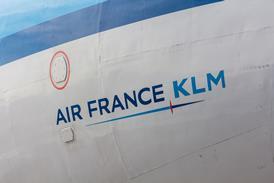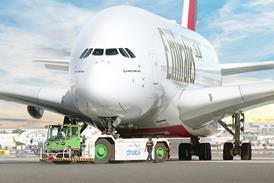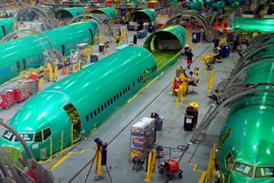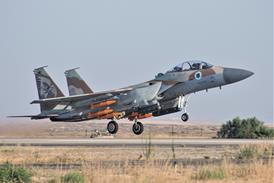What will follow the V-22? If tiltrotor pioneers Bell and Boeing can win US Army backing, a heavylift version could be under development in the next decade
With the V-22 Osprey entering military service next year and the civil BA609 progressing towards certification, tiltrotor pioneers Bell Helicopter and Boeing are stepping up work on the next frontier - the Quad TiltRotor (QTR) heavylift transport. With concept design funding from the US Army, the Bell Boeing tiltrotor team has been able to focus its ideas for scaling up the V-22 on the emerging requirement to move 20t payloads - including armoured vehicles - around the battlefield.
The QTR is one of five designs being explored under Joint Heavy Lift (JHL) concept design and analysis (CDA) contracts awarded in September last year and scheduled to run until next March. Data from the CDA phase is being used to develop requirements for the JHL which, if funded, could enter service around 2020.
Concept studies
Also engaged in CDA-phase studies are Boeing, with an advanced tandem-rotor helicopter (ATRH) that draws heavily on its cancelled XCH-62 Heavy Lift Helicopter of the 1970s Frontier Aircraft, pursuing a patented optimum-speed tiltrotor (OSTR) and Sikorsky, working on both low-speed and high-speed applications of its coaxial-rotor X2 Technology. The baseline JHL specification is to carry a Stryker or Future Combat Systems armoured vehicle over 460km (250nm).
For the CDA phase, the army divided the JHL concepts into three speed bands. With a cruise speed of 165kt (305km/h), Boeing's ATRH and Sikorsky's X2 Crane are in the low-speed band occupied by conventional helicopters. Sikorsky's 210kt X2 High Speed Lifter, with advancing-blade concept rotor and twin external propulsors, is in the mid-speed band. Bell Boeing's QTR, at 275kt, and Frontier's mysterious OSTR, at 310kt, are in the high-speed band beyond the reach of traditional rotorcraft.
The QTR concept has been around since 1998, but the JHL CDA "gave us the focus to do a deep dive and think about an objective aircraft", says Bell programme manager Alan Ewing. The 18-month, $3.45 million contract calls for data on a baseline aircraft, defined "with a reasonable level of fidelity", plus eight excursion designs with different payloads, ranges, operating conditions and basing options.
Bell Boeing completed the fourth iteration of its baseline design in August, and is working on the last, and most challenging, of the eight derivative designs: a QTR compatible with seabasing, a US Navy ship-to-shore concept of operations that requires a long-range heavylift capability.
Within the team, Boeing is responsible for the fuselage "and everything inside", from crew station to cargo handling, says Ewing. Bell is responsible for the wings - including nacelles, gearboxes, shafts and proprotors - as well as overall system integration. This arrangement echoes their work split on the V-22.
The design driver is proprotor diameter, because it affects aircraft size in a way unlike other rotorcraft. Keeping disc loading close to that of the V-22 results in a proprotor diameter of about 15.2m (50ft), compared with 11.6m for the Osprey. "That's a relatively small increase over our experience base," says Ewing.
Avoid interference
Proprotor diameter drives the span of the forward wing, with the need to provide 460mm (18in) clearance between blade tip and fuselage. To minimise interference between front and rear proprotors, the rear wing has a longer span and is set higher, to avoid intruding into the cargo box. Fuselage length is determined by the need to provide 915mm clearance between front and rear proprotor discs.
The result is an aircraft larger than the Lockheed Martin C-130, but capable of short or vertical take-off and landing. With a fuselage that is wider and longer than the C-130's, the baseline QTR has a cargo "box" length of almost 19m, which exceeds the JHL minimum requirement of 15.2m. Ewing says the longer cargo box "provides the stretch upfront", although it increases the pressure on an already weight-sensitive design.
Cargo space exceeds the JHL requirement by 25%, with the baseline QTR able to carry nine 463L cargo pallets, including one on the rear ramp, compared with the required six. Ewing says the extra space is useful because most cargo transports "cube out" before they reach maximum payload. The baseline design can carry up to 110 paratroops or 150 passengers, with the fuselage pressurised to 25,000ft altitude.
Bell Boeing has defined the baseline QTR with sufficient fidelity to allow the location and sizing of major systems. For balance, fuel is carried in the front and rear wings and in sponson tanks on the centre of gravity. An extendable aerial refuelling probe is fitted: "It's not required, but it's worthwhile," says Ewing. The twin tandem main gear and twin nosewheels are designed to allow rough-field operations at speeds up to 100kt for short take-offs and landings.
A key aspect of the design is the interconnection of the four identical proprotor gearboxes to provide engine-out capability. Forward and aft wing shafts and a centre shaft running between the wings along the top of the fuselage allow any proprotor to be powered by any engine, says Ewing. The centre shaft is sized for the worst case - driving the proprotors on a wing where both engines have failed.
Like all the JHL candidates, the QTR requires engines that do not exist in the USA today - 13,000-15,000shp (9,700-11,200kW) turboshafts. One possibility, says Ewing, is to combine two V-22-sized engines in each nacelle, driving the proprotor through a single gearbox.
JHL design excursions cover payloads ranging from 16t to 26t, mission radii from 460km to 925km, operating conditions of 4,000ft/35e_SDgrC (95e_SDgrF) and 6,000ft/35e_SDgrC, and baseline or large cargo box. Bell Boeing's large-fuselage, heavy-payload design has a 20.7m-long cargo box and can carry "things that don't fit in a C-130", says Ewing. Proprotor diameter increases by 1.5m and empty weight by 15%

Without folding
A seabase-compatible QTR "could be a bit of a problem", he says, "as we don't care to fold it" like the V-22, which has proprotor blades that fold to align with the wing and a wing that swivels to align with the fuselage. The baseline design does not require folding. "It gained nothing and saved weight," he adds. Without folding, eight QTRs could be accommodated on the deck of a CVN aircraft carrier.
To support its CDA study, Bell Boeing conducted a windtunnel test to address concerns that the wake from the forward wing and proprotors could adversely affect the rear wing and proprotors. "The worst condition is the front wingtip vortex hitting the rear proprotor at half span," says Ewing. Aeroelastic tests of a 1/5th-scale QTR half- model in NASA Langley's transonic dynamics tunnel showed blade loads on the rear proprotor were consistent with those on the front proprotor. "The effect of the vortex was minimal. Stability is no different to a conventional tiltrotor," he says.
The model represented Bell Boeing's proposed QTR demonstrator, which would use the three-blade proprotors and drive system from the V-22. Design is being refined under the CDA phase, with contractors required to submit plans for a large-scale flight vehicle to take their concept to a technology readiness level of 6, ready to enter development as early as 2013.
What happens next depends on the US Army, which, despite mounting budget pressures, hopes to increase spending on research and development, with JHL one of the beneficiaries. Bell Boeing, meanwhile, has briefed the US Air Force on the QTR as a candidate for its proposed AMC-X replacement for the C-130. "We have looked at AMC-X, and think QTR is very viable. They are interested, but still in the planning stages," says Ewing.
On paper, the timings for JHL and AMC-X are similar, with demonstrators flying early next decade and production by the end of the decade. But the future of both programmes is far from certain, with the cost of operations in Afghanistan and Iraq biting deep into US defence spending. For now, the QTR remains a concept.
Source: Flight International























